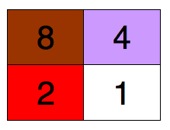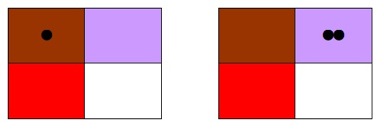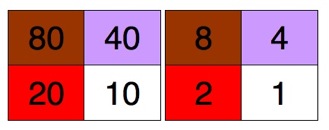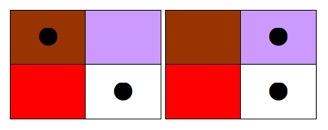

8° circolo didattico - Brindisi
Primary school “S. Pertini”
Aims:
- To learn mathematical concepts through experimentation
- To compare the binary and decimal systems.
Materials:
A series of tables like the one illustrated. The colours of the cells correspond to the Cuisenaire rods associated with the numbers 1, 2, 4 and 8. |
 |
Introduction:
The teacher explains the rules of the game to the pupils( a variation of the human abacus game)
- Placing 2 counters on the white square is the same as 1 counter on the red square (1 + 1 = 2).
- Placing 2 counters on the red square is the same as placing 1 counter on the purple square (2 + 2 = 4), etc.
Main part:
The teacher places a counter on the brown square: "That's 8", says a pupil. And the teacher asks " What other ways can we represent 8?" Another pupil says that 8 is the same as 4 + 4 and changes the counter on the brown square for 2 on the purple square.
 |
The teacher then puts 7 counters on the white square and the pupils change them by placing 3 counters on the red square and leaving 1 on the white square.
 |
Roundup:
Larger numbers are represented by adding a second table to the left of the first one with the numbers as illustated in the figure.
 |
|
For example, 95 is represented as shown: |
 |
The same method can be used to represent numbers with hundreds or thousands by adding more tables to the left. decimal numbers may also be represented by adding further tables to the right.
Observations:
- At www.rkennes.be/Papy-Minicomputer/minicomp-anglais.pdf there is an article written by Frederique Papy herself from October 1967 in which she explains how this application works,typical of the teaching of mathematics in the 60s,

